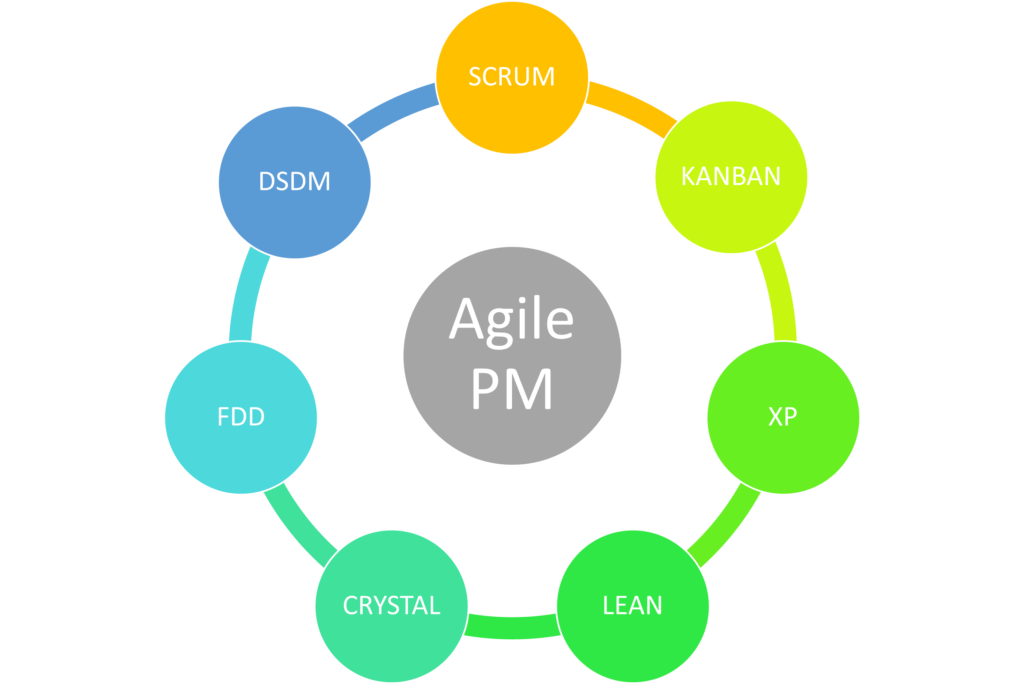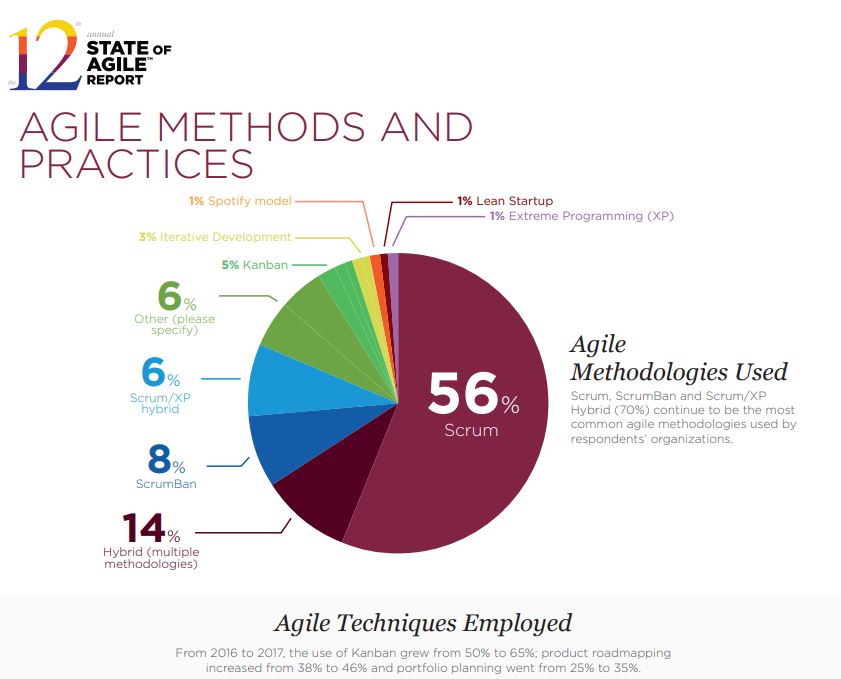Which Agile Project Management method to use is a pertinent debate among practitioners. Considering its flexibility and simplicity of adoption, it has become a go-to methodology for managing projects. The State of Agile Report published in 2018, studied the existence of 15 plus agile methodologies used among practitioners. In this article, we will focus on the 8 most used methodologies, including newly inducted ones that are gaining popularity very rapidly. We wrote a detail post on Agile project management vs Waterfall stating fundamental differences on the both principles of project management.
Agile project management is a project management method that focuses on delivering value to the customer through rapid, iterative cycles of development. There are several methods of agile project management, including Scrum, Kanban, and Lean.
8 Agile Project Management Methods: A detailed overview

1. Scrum
Scrum is a framework for managing and completing complex projects. It is one of the widely used and adopted agile project management methods. It is designed to be flexible and adaptable to change, and it is often used in software development. The Scrum process includes sprints, which are short, time-boxed periods of development, typically lasting 1-4 weeks. During each sprint, a cross-functional team works to deliver a potentially releasable product increment. The team holds daily stand-up meetings, called Scrums, to discuss progress and identify any obstacles. At the end of each sprint, the team holds a sprint review and retrospective to review what was accomplished and plan for the next sprint.
| Advantages | Disadvantages |
| Transparency allows the project to be followed by all the members of a team or even throughout the organization | The role of every developer is not well defined. May cause confusion |
| The definition of done allows a comparison of output with the intended | Does not focus on documentation and can be a major issue for knowledge management |
| Focus on quality is a top priority | |
| Backlog measured, velocity, and increments are critical here |
2. Kanban
Kanban is a method for managing work as it moves through a process. It is often used in manufacturing and service industries, and it is a popular choice for teams that need to manage a large number of items, such as bugs or customer requests. The Kanban process includes visualizing the workflow, limiting the amount of work in progress, and measuring lead time.
| Advantages | Disadvantages |
| Ability to view the entire status of the project in a single go | There is no time framing resulting in unusual Delays |
| Can limit the number of tasks running to focus on high priority | Possible only for smaller projects with somehow defined scopes |
| Heavily Focused on Delivery | |
| The methodology is very simple |
3. Lean
Lean is an approach to managing and improving processes that emphasize the elimination of waste and the continuous improvement of quality. It is often used in manufacturing and service industries and it is based on the principles of the Toyota Production System. Lean focuses on creating value for the customer, reducing waste, and improving efficiency.
| Advantages | Disadvantages |
| Waste Generation is minimal | Not much focus on documentation |
| An MVP way of Product development is used | Critical PM Functions like planning and monitoring is highly minimalized |
| Teams are focused on reducing waste upstream and downstream | Require a high degree of expertise as without it, waste cannot be identified |
4. XP or Extreme Programming
XP (Extreme Programming) is a software development methodology that emphasizes collaboration, simplicity, and frequent delivery of working software. XP is a highly disciplined approach that places a strong emphasis on programming practices, including testing, refactoring, and pair programming. The goal of XP is to deliver high-quality software that meets the needs of the customer. It is among the most preferred agile project management methods for code heavy industries.
| Advantages | Disadvantages |
| The simplicity of the written code is an advantage since it allows for improvement at any given time | Extreme focus on code and not on other aspects of managing a project |
| Promotes a highly energizing way of working | Not beneficial for geographically distributed teams |
5. Crystal
Crystal is a family of agile methodologies that are designed for specific types of projects and organizations. Each Crystal methodology has its own set of practices and guidelines, but they all share the same core values of communication, flexibility, and quality. Each crystal may or may not use a different agile project management methods for its execution
| Advantages | Disadvantages |
| Requires a technical environment with automated tests, configuration management, and frequent integration | Overdose of methodologies can cause confusion |
| Facilitates closer communication within teams and promotes interaction and knowledge-sharing between team members | Essential Parts of PM Like Planning and Reviews can be eliminated entirely |
6. DSDM
DSDM (Dynamic Systems Development Method) is an Agile agile project management method for managing projects. It is based on the principle that the best way to deliver a project is to involve the end user throughout the development process. DSDM focuses on delivering value to the customer and emphasizes rapid development, collaboration and flexibility.
7. FDD (Feature Driven Development)
FDD (Feature-Driven Development) is an Agile software Agile project management methods that emphasizes the delivery of small, incremental releases of working software. FDD is a model-driven approach that is based on the “feature” as the fundamental unit of work. It encourages frequent communication and collaboration between the development team and the customer.
8. SAFe (Scaled Agile Framework)
SAFe (Scaled Agile Framework) is an Agile framework for managing large, complex projects. It is designed to help organizations scale Agile methods to multiple teams and projects. SAFe emphasizes the importance of aligning the work of multiple teams to the overall goals of the organization and it is widely used in large organizations. Among its peers of agile project management methods, it has gained immense popularity recently
In summary, XP is a disciplined approach of Agile methodology that emphasizes programming practices, Crystal is a family of Agile methodologies tailored for specific types of projects and organizations, DSDM is an Agile framework for managing projects which focuses on delivering value to the customer, FDD is an Agile methodology that emphasizes on delivering small, incremental releases of working software and SAFe is an Agile framework for managing large, complex projects, aligning the work of multiple teams to the overall goals of the organization.
Scrum by far is the most popular method followed by Kanban and others. Here is a comparative adoption graphic adopted from the same report.

Each method of agile project management has its own strengths and weaknesses. Scrum is best used for complex projects that require a lot of coordination and collaboration, Kanban is best used for teams that need to manage a large number of items, and Lean is best used for teams that want to improve their process efficiency.
In summary, Agile project management methodologies like Scrum, Kanban, and Lean are widely used in software development and other industries for their ability to deliver value to the customer through rapid, iterative cycles of development. Each method has its own strengths and weaknesses and it’s best to choose the one that aligns with your project’s requirements, goals, and team’s capabilities.
Agile Project Management Methodology: Factors to Consider
When deciding which Agile Project Management method is the best for a particular project, there are several factors to consider
- Team size: Scrum is best suited for small teams of 7-9 members. Larger teams may require more structure and coordination, which can be achieved through the use
- Project complexity: Agile methodologies such as Scrum and Kanban are well-suited for projects with well-defined requirements and a clear understanding of the end goal. On the other hand, more complex projects, such as those involving multiple teams or a high level of uncertainty, may require a more flexible approach like Lean or SAFe.
- Team size and structure: Agile methodologies like Scrum work best with small, cross-functional teams. If the team is large or distributed, methodologies like SAFe or DSDM may be more suitable.
- Industry and domain: Different industries and domains may have their own specific requirements and constraints. For example, Scrum is commonly used in software development, while Kanban is often used in manufacturing and service industries.
- Business goals: The specific business goals and objectives of the project should also be taken into account when choosing an Agile methodology. For example, if the goal is to deliver a product increment as soon as possible, Scrum may be the best choice, whereas if the goal is to improve process efficiency, Lean may be the best choice.
- Communication and collaboration: The Agile methodology should also align with the team’s communication and collaboration style. For instance, if the team prefers frequent and direct communication, Scrum or FDD would be a good fit.
In summary, the best Agile methodology to use depends on the specific characteristics of the project, the team, and the business goals. It’s important to evaluate the project’s complexity, team size, industry, domain, and business goals, as well as communication and collaboration style to make an informed decision.
Samrat is a Delhi-based MBA from the Indian Institute of Management. He is a Strategy, AI, and Marketing Enthusiast and passionately writes about core and emerging topics in Management studies. Reach out to his LinkedIn for a discussion or follow his Quora Page
